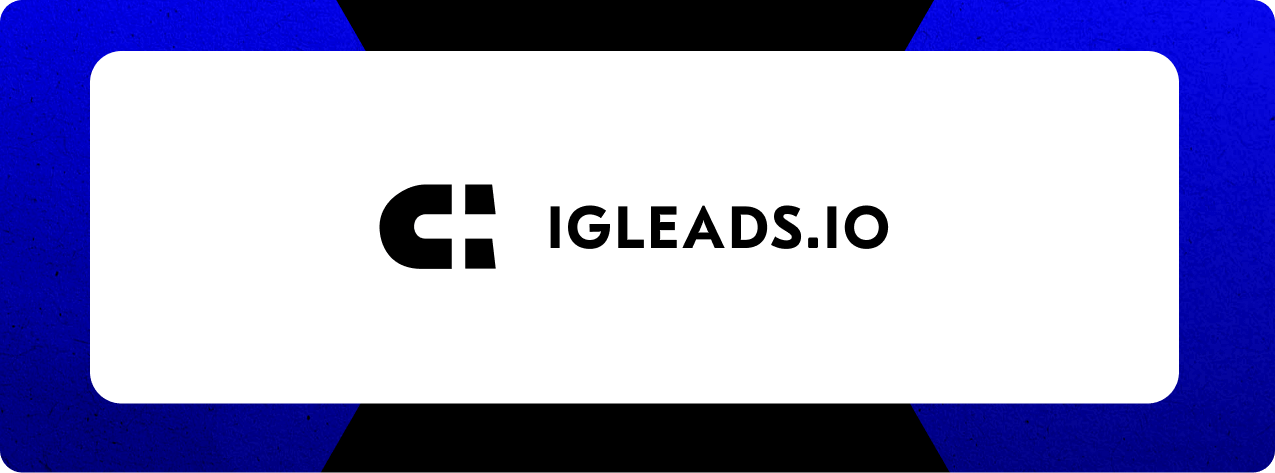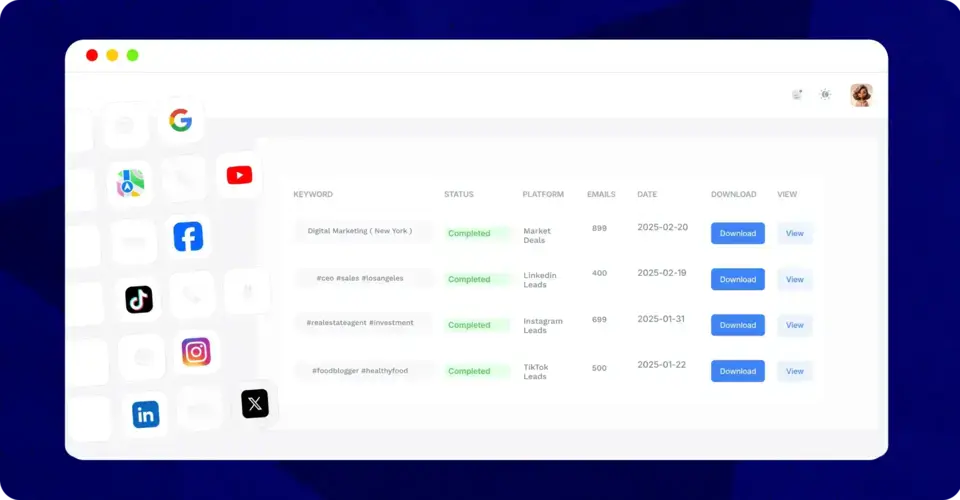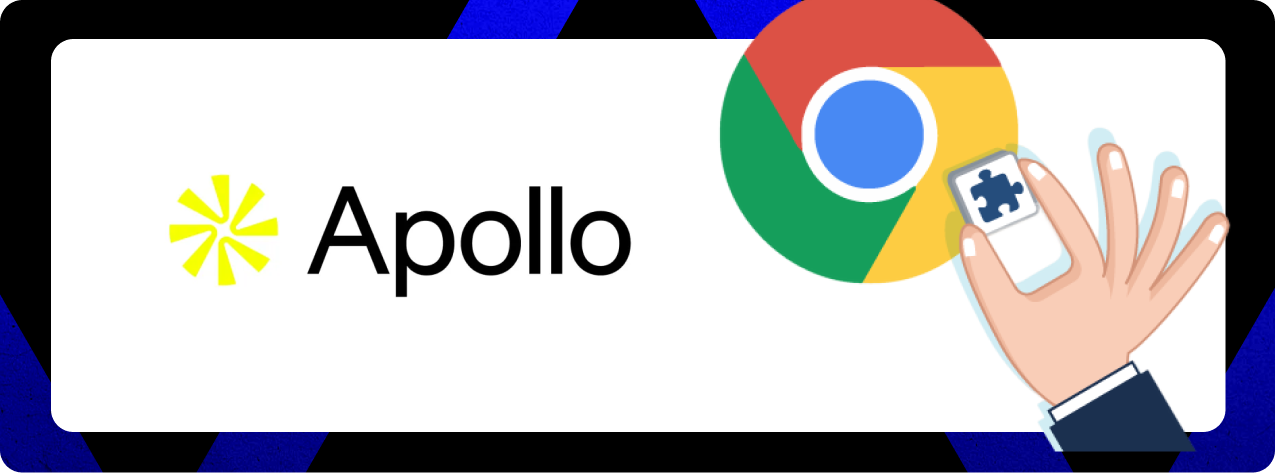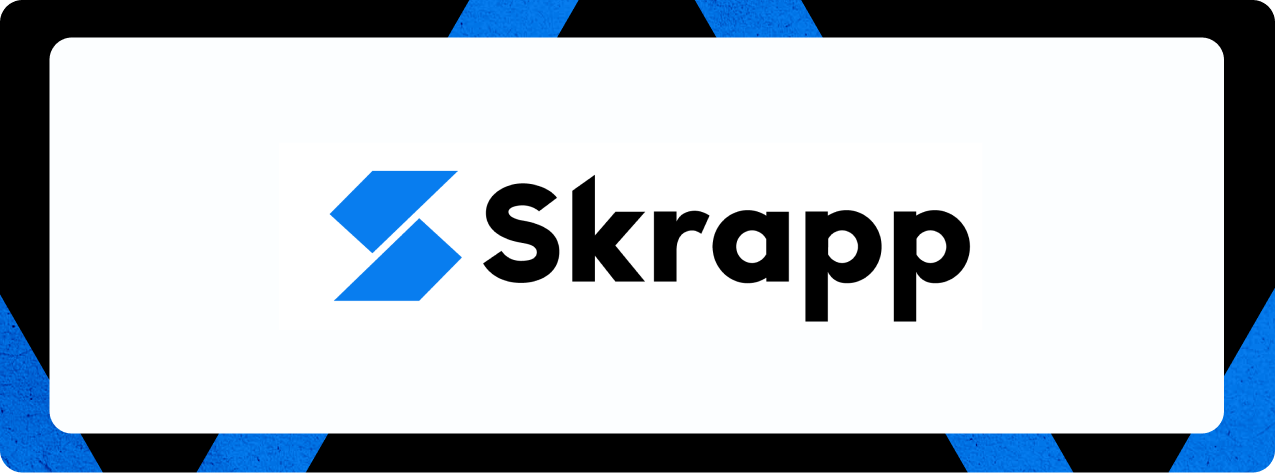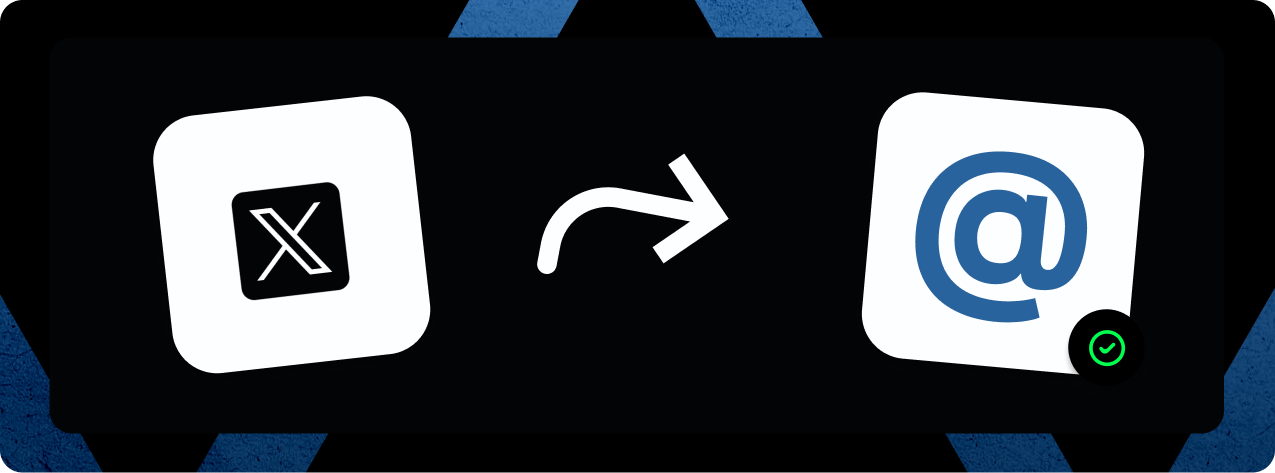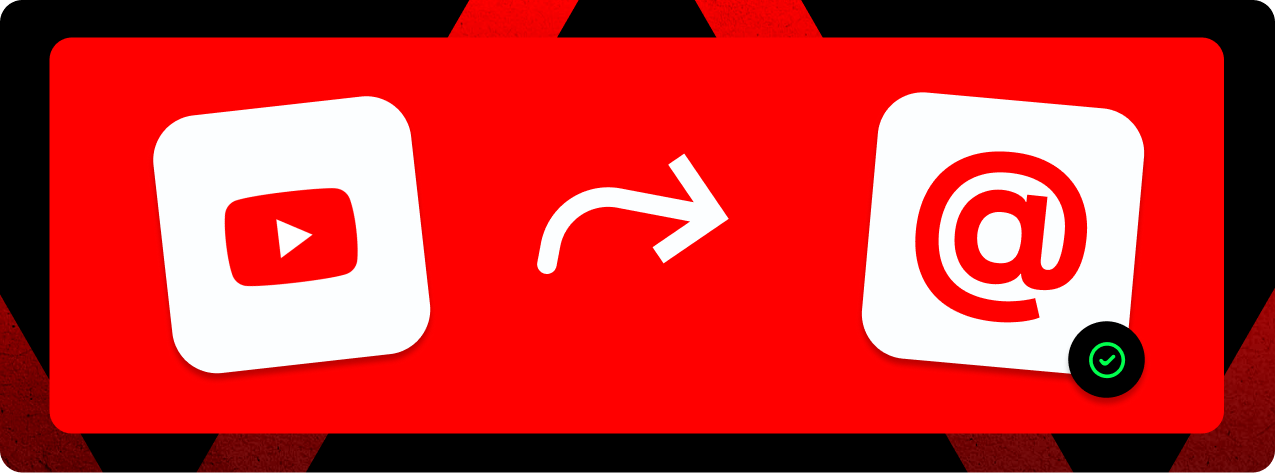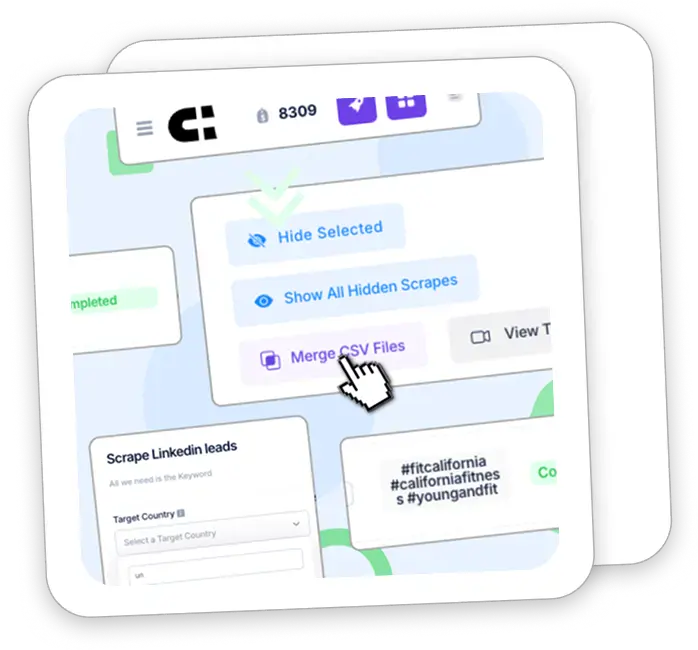How to Scrape Twitter Emails in 2025: Tools & Guide
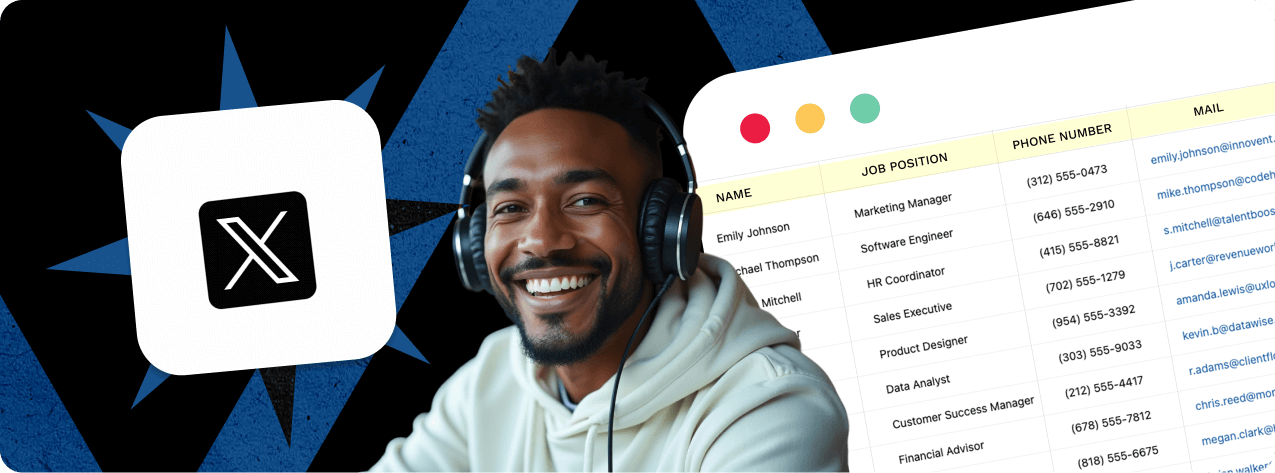
Looking to pull email contacts from Twitter in 2025? You’ve got two paths: dig through bios and replies manually, or use a Twitter email scraper to do the heavy lifting.
Advanced scraping tools now process millions of Twitter profiles daily, unlocking a powerful stream of business data. Tools like Apollo.io enrich leads from multiple sources, but purpose-built solutions like IGLeads make Twitter email extraction faster and easier, no logins, no proxies, no fluff.
Whether you’re trying to build outbound lists or reach influencers in a specific niche, Twitter scraping tools save hours of manual effort and give you access to valuable outreach data. Combine that with the $42 return per $1 spent on email marketing, and it’s easy to see why this tactic has become so popular.
This guide walks you through both manual and automated approaches. You’ll learn the best Twitter email scraper tools, how to use them, and what to watch out for. If you’re in a hurry, jump to our tool comparison for the top email scraping options in 2025.
Let’s get started.
Understanding Twitter email scraping
Before diving into the tools, it’s worth breaking down what Twitter email scraping actually means and why it matters in 2025, especially for marketers, founders, or recruiters trying to connect with specific audiences.
What is Twitter email scraping?
Twitter email scraping refers to the process of extracting public email addresses and other contact information from Twitter profiles, tweets, and user-linked metadata. Rather than scrolling endlessly through profiles, a Twitter email scraper automates this collection process, organizing the results into usable lists for outreach, marketing, or lead generation.
Most scrapers start by analyzing public bios, pinned tweets, or URLs linked to websites and personal pages. From there, they can dig deeper, scanning associated domains, analyzing cross-platform profiles, or identifying patterns based on usernames and keywords.
Depending on the tool, a scraper might also collect:
- Names and Twitter handles
- Bio keywords and hashtags
- Location data
- Linked website URLs
- Follower/following metrics
- Engagement metrics (likes, retweets, replies)
Keep in mind: a good scraper only pulls publicly available data. That means no login-required info, no scraping of private DMs, and no bypassing of user controls. Anything beyond that risks violating Twitter’s Terms of Service — and potentially data privacy laws like GDPR and CCPA.
Types of email scraping tools
In 2025, Twitter scraping tools range from lightweight browser plugins to full-scale enterprise platforms:
- Basic tools scan bios and websites for email mentions
- AI-driven tools guess email formats using domain logic and name data
- Enterprise tools use API access, proxies, and enrichment engines for broader datasets
Each comes with its own pros and trade-offs, which we’ll explore in the next section.
Top 5 Twitter email scraping tools in 2025
Twitter has become a goldmine for outbound leads, and in 2025, several platforms stand out when it comes to extracting emails efficiently, safely, and at scale. Here’s a quick breakdown of five top tools, including both B2B data giants and social scraping specialists:
| Feature |  |
 |
 |
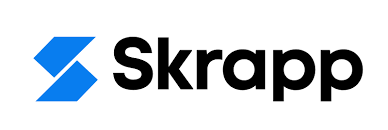 |
 |
|---|---|---|---|---|---|
| Key features | – No login or proxy needed – Keyword-based scraping – AI assistant for search – Multi-platform support |
– Twitter enrichment via database match – CRM integrations – AI-powered contact search – Sales cadences |
– Matches Twitter to B2B contact records – Deep filters – Intent and firmographic data |
– Chrome scraping extension – Domain-based email finder – Pattern guessing – Email verification |
– Email format prediction – Domain-level scraping – Free email checker |
| Pros | – Fast setup – Budget-friendly – Export-ready CSVs |
– High data accuracy – Outbound workflow ready |
– Rich, verified data – Enterprise scalability |
– Fast data pull – Simple interface |
– Easy to use – Good for small campaigns |
| Cons | – Basic filtering – No deep targeting |
– Learning curve – Paid-only exports |
– Very expensive – No self-serve plans |
– Less accurate on Twitter – No social enrichment |
– Limited filtering – Surface-level contact data |
| Starting price | $59.99/month | $59/month and up | Custom annual plan | Free, then $49/month | Free, then $49/month |
1. IGLeads – Twitter scraping with no login required
IGLeads.io was designed for marketers who want fast, clean Twitter leads without worrying about proxies, browser sessions, or technical setup.
You just plug in a keyword, like “fitness coach” or “web3 founder”, and we extract public data (including emails when listed or linked) from matching Twitter bios. It runs completely cloud-based, meaning no risk of rate limits or bans.
- No login, proxy, or Chrome extension
- Built-in AI assistant suggests top keywords
- Format and deduplicate emails automatically
- Includes Instagram, LinkedIn, TikTok, Facebook scraping
Pricing:
- Starter – $59.99/month for 10,000 emails
- Business – $149.99/month for unlimited use
2. Apollo.io – Enrichment engine with Twitter integrations
Apollo isn’t just a B2B database, it’s one of the most powerful Twitter email enrichment tools available. With recent updates, Apollo can now connect social profiles (like Twitter) to its contact database and enrich them with verified emails, phone numbers, and job titles.
If you’re already running outbound campaigns or need CRM-ready data, Apollo offers built-in cadences and integrations with tools like Salesforce and HubSpot.
Best for: teams running advanced, multi-channel outreach
Pricing:
- Free plan with limited credits
- Paid plans from $59/month to $499+/month
3. ZoomInfo – Enterprise contact scraping with intent data
ZoomInfo uses its massive business contact database to match Twitter handles to real decision-makers, giving you deep enrichment like industry, revenue, company size, and direct emails. While it doesn’t scrape Twitter directly, it integrates social signals into its contact intelligence framework.
This is ideal for B2B users who want more than just a name and email, and who need verified, high-quality contacts at scale.
Pricing:
- ZoomInfo plans are contract-based and typically start at $10,000/year. No free tier.
4. Skrapp – Chrome-based scraping with email prediction
Skrapp is best known for LinkedIn data, but it also supports Twitter domain-level email discovery. You input a website, and Skrapp finds matching public emails, often using social usernames to assist in matching.
If a Twitter user links to their website in bio, Skrapp can often fill in the gaps using a mix of email pattern guessing and enrichment databases.
Pricing:
- Free tier with 150 credits
- Paid plans start at $49/month for 1,000 credits
5. Hunter.io – Public email finder with format logic
Hunter is a classic in the email scraping world. For Twitter, it works best when the user links to a website, because Hunter then runs a domain scan to uncover common email formats or public contacts from that site.
It doesn’t actively scrape Twitter’s UI, but it pairs nicely with basic manual or browser scraping workflows to enrich missing data.
Pricing:
- Free plan with 25 monthly searches
- Paid plans from $49/month to $399/month
Manual vs automated methods
When it comes to pulling email addresses from Twitter, the method you choose depends heavily on your project’s size, timeline, and targeting goals. Below, we’ll break down how manual email scraping works in 2025 and when it makes sense to use a Twitter email scraper instead.
How to manually find emails on Twitter
Manual email extraction is still surprisingly effective, especially for small, niche-targeted campaigns. Many Twitter users include email addresses in their bios, tweets, or link to personal websites where contact info is easy to find.
Here’s how to manually gather emails:
- Scan bios for direct emails
Many creators and professionals list their email in formats like:📧 john.smith@gmail.comorContact: hello@xyzagency.com - Check tweet history
Some users post their contact details in tweets pinned for outreach or business. - Look at linked websites
Click the link in the user’s bio. If it leads to a personal or business website, check the contact page, then use a tool like Hunter.io or Mailshake to confirm the email format. - Use advanced Google search operators
Example:site:twitter.com "web designer" gmail.com
This helps surface Twitter profiles that mention public Gmail addresses.
Manual scraping works best on the mobile app, where Twitter’s layout makes bio content easier to scan quickly. You’ll average around 10–20 valid emails per hour if you work consistently.
When to use an automated Twitter email scraper
Manual searching hits a wall fast, especially when your target list grows beyond a few dozen contacts. That’s where automation becomes essential.
Use a Twitter email scraper when:
- You need more than 30–50 leads quickly
- You want to extract emails across a specific niche or region
- You plan to enrich data for CRM upload or cold email campaigns
- You need to run multi-platform scraping from a single dashboard
- You’re working with a team or need repeatable workflows
Tools like IGLeads and Apollo can deliver hundreds of formatted contacts per day, automatically removing duplicates and enriching the data with job roles, websites, or phone numbers.
Pros and cons of each method
| Approach | Pros | Cons |
|---|---|---|
| Manual | – Highly targeted – No cost – Validity confirmed by eye |
– Time-consuming – Low scale – Easy to miss hidden leads |
| Automated | – Scales to thousands of leads – Fast & efficient – Enriched, export-ready data |
– Requires a paid tool – Some emails may be outdated – Legal/ethical risks if misused |
Manual works great for hyper-local outreach, freelancer prospecting, or influencer collaboration. Automation is the clear winner for SaaS sales, agency lead gen, or outbound marketing at scale.
Setting up your Twitter scraping workflow with IGLeads
Scraping Twitter emails doesn’t have to feel like a technical project. With IGLeads, the process is simple, fast, and 100% cloud-based, no proxies, no Chrome extensions, and no account logins required.
Whether you’re a solo founder or a full sales team, you can collect hundreds of public emails from Twitter in minutes using keyword-based targeting.
Step-by-step: How to use IGLeads to extract Twitter emails
- Log into your IGLeads dashboard
Once you’re in, choose the Twitter Scraper from the list of available tools. - Enter your keyword or niche
Type in a niche or job keyword like “real estate agent,” “startup founder,” or “crypto newsletter.”
Not sure where to start? Our built-in AI assistant can suggest high-performing keyword combinations for your audience. - Choose how many contacts you want
Pick your desired quantity, from a few hundred to thousands, depending on your plan and outreach goals. - Click “Start Scraping”
Our system runs in the background. You don’t need to stay on the page or manage proxy/IP settings. It’s fully automated and compliant with Twitter’s public data guidelines. - Download your cleaned CSV file
Once finished, IGLeads formats the data for you: deduplicated, structured, and ready to import into your CRM, email platform, or spreadsheet.
Best practices and common pitfalls
Scraping Twitter emails can be extremely effective, but only if you do it the right way. Whether you’re using IGLeads or another platform, the success of your outreach depends on how clean, compliant, and organized your process is.
Avoiding rate limits and detection
With IGLeads, scraping is handled off-platform through cloud servers, so there’s no risk of rate limits or IP bans. But if you’re using browser-based tools or Chrome extensions, keep these practices in mind:
- Avoid scraping too many profiles in a short time
- Use residential proxies (not datacenter) if the tool requires them
- Randomize scraping intervals and avoid predictable patterns
- Never connect scrapers directly to your Twitter account
For teams building custom workflows, distribute tasks across multiple environments or time blocks to reduce friction.
Staying compliant with data privacy laws
Since 2023, data privacy regulations have tightened globally. Whether you’re collecting emails from individuals or businesses, it’s your responsibility to ensure your scraping and outreach workflows are compliant.
Here are key legal points to consider in 2025:
- Public vs private data: Only scrape emails that are publicly available — such as those listed in Twitter bios, tweets, or user-linked websites. Avoid collecting data behind logins, private accounts, or scraped via unauthorized automation.
- GDPR (EU): You must have a lawful basis for processing personal data. Cold outreach for legitimate interest is allowed, but only if it’s relevant, targeted, and includes a clear opt-out.
- CCPA (California): California residents have the right to know what data you collect and to request deletion. Always honor opt-outs and avoid reselling scraped data without consent.
- CAN-SPAM (U.S.): All outreach emails must include your contact information, a real subject line, and an easy way to unsubscribe. Failing to do so can trigger penalties.
- Commercial use risk: Twitter’s terms of service prohibit scraping for commercial purposes using bots or unauthorized tools. This means tools that log in, simulate user behavior, or over-query endpoints could put you at risk of an IP ban or legal escalation.
IGLeads is designed to stay on the safe side by only collecting public data, without accessing private accounts or requiring user login. Our cloud-based model avoids bot-like behavior entirely, keeping your campaigns simple, scalable, and within the boundaries of ethical data collection.
When in doubt, prioritize quality over quantity, offer easy opt-outs, and don’t treat scraped data as a shortcut for spam.
Organizing and storing your data securely
Once you’ve collected Twitter emails, the next step is securing and organizing the list properly:
- Store data in encrypted cloud platforms (Google Drive, Notion, or a secure CRM)
- Avoid sharing raw lists across unprotected channels (Slack, email, etc.)
- Back up your data regularly in case of loss or overwrite
IGLeads exports your emails in a clean CSV format, already deduplicated and pre-formatted, so there’s no need to waste time on cleanup or re-sorting.
Improving email deliverability
Scraped emails don’t always equal deliverable emails. Here’s how to maximize your open rates and avoid spam folders:
- Run your list through an email validation tool (e.g. NeverBounce, Bouncer, or Emailable)
- Remove any catch-all or role-based emails (like support@ or info@)
- Warm up your sending domain if you’re doing cold outreach
- Personalize your emails with details from bios or tweets when possible
Clean lists lead to higher open rates, more replies, and fewer bouncebacks.
Why Twitter is your untapped lead engine in 2025
Most people scroll Twitter for opinions and trending topics. But under the surface, it’s one of the most underrated contact databases available today — especially if you know how to extract and use the right information.
From solo creators listing their Gmail in a bio to founders tweeting their Calendly links, Twitter is full of outreach-ready signals just waiting to be tapped.
Whether you’re building your next cold email list, targeting influencers, or scaling a lead-gen agency, a well-executed scraping workflow lets you unlock massive potential — without getting your hands dirty.
The right tool makes all the difference. Just stay compliant, clean your data, and focus on quality over quantity.
If you’re ready to start, IGLeads is built to make Twitter scraping simple, automated, and scalable — no code, no logins, no stress.
More step-by-step scraping guides
- How to Scrape TikTok Emails in 2025: Tools & Guide
- How to Scrape Google Maps Emails in 2025: Tools & Guide
- How to Scrape Google Emails in 2025: Tools & Guide
- How to Scrape LinkedIn Emails in 2025: Tools & Guide
- How to scrape Facebook emails in 2025: tools & guide
- How to Scrape Instagram Emails in 2025: Tools & Guide
- How to cancel Sales Navigator and switch to a simpler lead tool
- How To Find Someone with Just a First Name and Age
Frequently Asked Questions
Scraping publicly listed emails from Twitter bios, tweets, or linked websites is generally legal, but only if used responsibly. That means no scraping of private data, no reselling without consent, and always respecting data privacy laws like GDPR and CCPA. Twitter’s Terms of Service prohibit unauthorized automation, so avoid using bots or logged-in scrapers.
It depends on your use case. For fast, keyword-based scraping without logins or proxies, IGLeads is one of the simplest options. If you need verified B2B data, tools like Apollo.io or ZoomInfo offer deeper enrichment but at a higher cost. For smaller teams, Skrapp and Hunter.io work well if your leads include domain links.
Yes, especially for small, targeted lists. Many users include emails in bios, tweets, or linked personal websites. You can also use Google search operators to surface profiles with Gmail, Yahoo, or business domain emails. Manual lookup is slower but offers precise control and higher email validity.
That depends on your plan and keyword breadth. IGLeads users typically collect hundreds to thousands of emails per campaign, depending on niche size. The system automatically deduplicates, formats, and structures results into a clean CSV for export.
Run your list through a verification tool before sending. Remove catch-all domains, avoid generic addresses like info@ or admin@, and personalize your emails based on bio info. If you’re doing cold outreach, warm up your sending domain and space your campaigns out to avoid spam flags.
